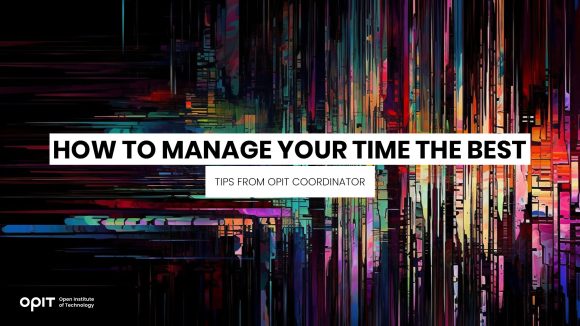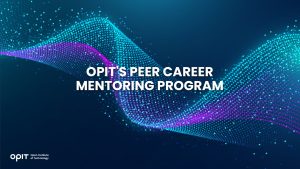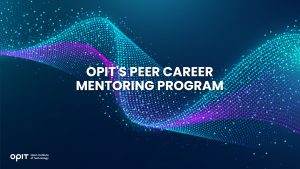

Online studying offers numerous benefits. You get to learn at your own pace (from the comfort of your home), access significantly more resources, and manage your schedule. But that last part isn’t always easy.
When left to your own devices, you might start procrastinating and losing track of time. Then, before you know it, finals are approaching, and you’re nowhere near prepared.
Luckily, we have a solution for this common challenge here at the Open Institute of Technology (OPIT)—or two solutions, to be precise.
One, there are no finals. You’re continually assessed by the incredible faculty, pushing you to engage with the material throughout the course. And two, OPIT’s amazing class coordinator, Sara Ciabattoni, is here to help you overcome specific challenges with procrastination and other issues (e.g., complex and overwhelming tasks).
For this guide, we asked Sara to share her top 10 time management tips. Since time is money, let’s dive in!
1. Reflect on Your Current Time Management Approach
Do you constantly feel overwhelmed and fail to keep up with your tasks? If so, something’s not working. It’s probably time to reassess your approach to time management. And by this, Sara doesn’t just mean your studying time. Instead, she implores you to reflect on how you usually manage time in your everyday life.
Become aware of your time management habits (both good and bad), and a more effective approach to studying is right around the corner.
Let’s say you excel at focusing in the morning but find it difficult to do so in the afternoon. In that case, leave your most demanding study tasks for the morning, aka your peak focus hours. The more time passes, the less complex your tasks should be.
Similarly, if you tend to procrastinate, your goal is to answer a single question – why?
Sometimes, the cause is something silly, such as the so-called FOMO (Fear of Missing Out), which keeps you glued to your screen. In other situations, the cause might be more serious (e.g., an innate fear of failure). Whatever the case, address these underlying issues promptly, as this is the only way to make the most out of your study time.
2. Create a Manageable Routine
No one can do it all at once (And no one should!). So, start by making a list of priorities and turning them into a to-do list. Make seven to-do lists, and you have a manageable weekly schedule that suits your day-to-day life.
If you struggle with prioritizing tasks, you can use the ABC method. Here’s an example to help you visualize this method in practice.
Let’s say you’re pursuing a Bachelor’s Degree (BSc) in Modern Computer Science at OPIT. The elective “Agile Development and DevOps” subject teaches you to implement software projects successfully.
For this subject, an “A” task would be to prepare for a specific real-world scenario developers encounter every day. You’ll experience several of these valuable and time-sensitive scenarios, making them tasks of the highest priority.
For a “B” task, you can practice using Microsoft Azure. This task is important but not as urgent as your “A” task.
Finally, a “C” task can entail working on your negotiation skills to help you convince team members to adopt a specific DevOps methodology. As you can probably guess, “C” tasks are tasks of lower priority, usually because they’re less time-sensitive.
3. Introduce Variety
Sure, this tip doesn’t directly impact your time management. However, it does play a huge role in whether you’ll stick to your studying routine.
If you always study in the same place and in the same way, you’re bound to get bored and lose motivation. So, try mixing things up a little.
For instance, instead of re-reading the course materials over and over again to memorize them, try turning them into a flowchart or a mind map. These handy visual tools can help you grasp concepts differently and make studying more engaging.
4. Take Advantage of All the Available Resources
OPIT prides itself on the wealth of resources available to students, each crafted from scratch. But these resources aren’t only concerned with studying. The OPIT Hub also contains helpful tools you can use to navigate your online studying journey.
One of these resources is a weekly planner designed to turn your priorities into a manageable weekly schedule. Like everything at OPIT, this planner is highly customizable, allowing you to tailor it to your unique needs and preferences.
5. Connect With Others
At OPIT, we also set priorities. One of them is for our students to never feel alone. That’s why we offer an extensive support network to ensure you always have someone to turn to.
So, don’t hesitate to ask for help if you feel stuck or lost. Besides OPIT’s staff, you should connect with your peers and even form online study groups. This will help you keep up with your tasks in a more collaborative and supportive environment. And hey – you might even get to make new friends from all over the world!
6. Don’t Forget About Downtime
Creating a solid schedule isn’t about filling every available moment with a task. Sure, it’s important to get your work done. However, it’s equally crucial to prevent burnout. How can you do this? By including downtime in your schedule.
Of course, you can use your downtime however you see fit. But Sara suggests spending it with your loved ones whenever possible. This will boost your mood and overall well-being, making subsequent studying a breeze. It will also help you achieve the most coveted of all goals – a healthy work-life balance.
But don’t forget – “work” is still a key element of this balance. So, make sure the people in your life also know your schedule (and are willing to respect it).
7. Never Sacrifice Your Basic Needs
Sure, it might seem to you that you’ll get more done if you wake up super early. But this couldn’t be further from the truth. Failing to get enough sleep can only make you less productive, both that day and in the long run.
So, make sure you leave enough time for a good night’s sleep in your schedule. For the best possible results, aim for seven to nine hours.
8. Avoid Jam-Packing Your Schedule
When it comes to estimating how much time you need to allocate for a specific task, remember this – it’s better to be safe than sorry.
Overestimating the time you’ll need for a complex task trumps underestimating every single time. Why? If you underestimate the time you’ll need to complete a task, you’ll feel extremely stressed upon realizing that your deadline is approaching and the work is not yet completed. This will cause you to fall behind on your entire schedule or, even worse, rush through work and compromise its quality.
Overestimating, on the other hand, provides a safety net for unforeseen challenges. Finish the task(s) before the allocated time, and you’ll feel a sense of accomplishment like no other! But it’s OK even if you don’t, as there’s enough time for everything.
Another approach you can take is to break larger tasks into smaller, more manageable chunks. Then, you can allocate a shorter amount of time to each sub-task and feel great when you get it done.
9. Be Kind to Yourself
You can devise the perfect studying plan for the week with enough room for studying, revising, and relaxing. You can even go into the week refreshed, ready to take on any challenge. And yet, it can all fall apart the second that week begins. And that’s OK!
Some days just don’t go as planned. You might receive some bad news or encounter unexpected challenges that disrupt your schedule.
So, be kind to yourself if you’re going through one of these days. Remember that the day will pass just as quickly as it came, and you’ll be back on track in no time.
10. Measure (and Celebrate) Your Progress
How can you tell whether your schedule is truly working? By measuring your progress, of course! Format every task as a SMART goal, and you’ll always know where you stand.
Let’s see what this means using another subject at OPIT – “Web Development.”
- Specific: “I will learn to create a domain hosting comparison report.”
- Measurable: “I will create at least three reliable reports.”
- Attainable: “I have already received the theoretical knowledge necessary for this task.”
- Relevant: “Creating these reports will enhance my understanding of existing domain host options.”
- Time-bound: “I will complete the three reports by the end of the week.”
If you succeed in completing these reports by the end of the week, give yourself a little reward. It’s crucial for you to celebrate your progress, no matter how small or big. This is the only way to stay motivated in the long run and maintain a positive mindset throughout your academic journey at OPIT.
There’s No One-Size-Fits-All Solution
When it comes to student support, OPIT emphasizes a personal approach to every student. That’s why it’s crucial to remember that no single time management solution will help all students. After all, each student faces specific challenges, leads a unique lifestyle, and has an individual learning style.
However, as long as you combine Sara’s tips with methods that have proven successful for your specific circumstances (and preferences), you should have no issue excelling at online studying.
Related posts

Source:
- Raconteur, published on November 06th, 2025
Many firms have conducted successful Artificial Intelligence (AI) pilot projects, but scaling them across departments and workflows remains a challenge. Inference costs, data silos, talent gaps and poor alignment with business strategy are just some of the issues that leave organisations trapped in pilot purgatory. This inability to scale successful experiments means AI’s potential for improving enterprise efficiency, decision-making and innovation isn’t fully realised. So what’s the solution?
Although it’s not a magic bullet, an AI operating model is really the foundation for scaling pilot projects up to enterprise-wide deployments. Essentially it’s a structured framework that defines how the organisation develops, deploys and governs AI. By bringing together infrastructure, data, people, and governance in a flexible and secure way, it ensures that AI delivers value at scale while remaining ethical and compliant.
“A successful AI proof-of-concept is like building a single race car that can go fast,” says Professor Yu Xiong, chair of business analytics at the UK-based Surrey Business School. “An efficient AI technology operations model, however, is the entire system – the processes, tools, and team structures – for continuously manufacturing, maintaining, and safely operating an entire fleet of cars.”
But while the importance of this framework is clear, how should enterprises establish and embed it?
“It begins with a clear strategy that defines objectives, desired outcomes, and measurable success criteria, such as model performance, bias detection, and regulatory compliance metrics,” says Professor Azadeh Haratiannezhadi, co-founder of generative AI company Taktify and professor of generative AI in cybersecurity at OPIT – the Open Institute of Technology.
Platforms, tools and MLOps pipelines that enable models to be deployed, monitored and scaled in a safe and efficient way are also essential in practical terms.
“Tools and infrastructure must also be selected with transparency, cost, and governance in mind,” says Efrain Ruh, continental chief technology officer for Europe at Digitate. “Crucially, organisations need to continuously monitor the evolving AI landscape and adapt their models to new capabilities and market offerings.”
An open approach
The most effective AI operating models are also founded on openness, interoperability and modularity. Open source platforms and tools provide greater control over data, deployment environments and costs, for example. These characteristics can help enterprises to avoid vendor lock-in, successfully align AI to business culture and values, and embed it safely into cross-department workflows.
“Modularity and platformisation…avoids building isolated ‘silos’ for each project,” explains professor Xiong. “Instead, it provides a shared, reusable ‘AI platform’ that integrates toolchains for data preparation, model training, deployment, monitoring, and retraining. This drastically improves efficiency and reduces the cost of redundant work.”
A strong data strategy is equally vital for ensuring high-quality performance and reducing bias. Ideally, the AI operating model should be cloud and LLM agnostic too.
“This allows organisations to coordinate and orchestrate AI agents from various sources, whether that’s internal or 3rd party,” says Babak Hodjat, global chief technology officer of AI at Cognizant. “The interoperability also means businesses can adopt an agile iterative process for AI projects that is guided by measuring efficiency, productivity, and quality gains, while guaranteeing trust and safety are built into all elements of design and implementation.”
A robust AI operating model should feature clear objectives for compliance, security and data privacy, as well as accountability structures. Richard Corbridge, chief information officer of Segro, advises organisations to: “Start small with well-scoped pilots that solve real pain points, then bake in repeatable patterns, data contracts, test harnesses, explainability checks and rollback plans, so learning can be scaled without multiplying risk. If you don’t codify how models are approved, deployed, monitored and retired, you won’t get past pilot purgatory.”
Of course, technology alone can’t drive successful AI adoption at scale: the right skills and culture are also essential for embedding AI across the enterprise.
“Multidisciplinary teams that combine technical expertise in AI, security, and governance with deep business knowledge create a foundation for sustainable adoption,” says Professor Haratiannezhadi. “Ongoing training ensures staff acquire advanced AI skills while understanding associated risks and responsibilities.”
Ultimately, an AI operating model is the playbook that enables an enterprise to use AI responsibly and effectively at scale. By drawing together governance, technological infrastructure, cultural change and open collaboration, it supports the shift from isolated experiments to the kind of sustainable AI capability that can drive competitive advantage.
In other words, it’s the foundation for turning ambition into reality, and finally escaping pilot purgatory for good.

The Open Institute of Technology (OPIT) is the perfect place for those looking to master the core skills and gain the fundamental knowledge they need to enter the exciting and dynamic environment of the tech industry. While OPIT’s various degrees and courses unlock the doors to numerous careers, students may not know exactly which line of work they wish to enter, or how, exactly, to take the next steps.
That’s why, as well as providing exceptional online education in fields like Responsible AI, Computer Science, and Digital Business, OPIT also offers an array of career-related services, like the Peer Career Mentoring Program. Designed to provide the expert advice and support students need, this program helps students and alumni gain inspiration and insight to map out their future careers.
Introducing the OPIT Peer Career Mentoring Program
As the name implies, OPIT’s Peer Career Mentoring Program is about connecting students and alumni with experienced peers to provide insights, guidance, and mentorship and support their next steps on both a personal and professional level.
It provides a highly supportive and empowering space in which current and former learners can receive career-related advice and guidance, harnessing the rich and varied experiences of the OPIT community to accelerate growth and development.
Meet the Mentors
Plenty of experienced, expert mentors have already signed up to play their part in the Peer Career Mentoring Program at OPIT. They include managers, analysts, researchers, and more, all ready and eager to share the benefits of their experience and their unique perspectives on the tech industry, careers in tech, and the educational experience at OPIT.
Examples include:
- Marco Lorenzi: Having graduated from the MSc in Applied Data Science and AI program at OPIT, Marco has since progressed to a role as a Prompt Engineer at RWS Group and is passionate about supporting younger learners as they take their first steps into the workforce or seek career evolution.
- Antonio Amendolagine: Antonio graduated from the OPIT MSc in Applied Data Science and AI and currently works as a Product Marketing and CRM Manager with MER MEC SpA, focusing on international B2B businesses. Like other mentors in the program, he enjoys helping students feel more confident about achieving their future aims.
- Asya Mantovani: Asya took the MSc in Responsible AI program at OPIT before taking the next steps in her career as a Software Engineer with Accenture, one of the largest IT companies in the world, and a trusted partner of the institute. With a firm belief in knowledge-sharing and mutual support, she’s eager to help students progress and succeed.
The Value of the Peer Mentoring Program
The OPIT Peer Career Mentoring Program is an invaluable source of support, inspiration, motivation, and guidance for the many students and graduates of OPIT who feel the need for a helping hand or guiding light to help them find the way or make the right decisions moving forward. It’s a program built around the sharing of wisdom, skills, and insights, designed to empower all who take part.
Every student is different. Some have very clear, fixed, and firm objectives in mind for their futures. Others may have a slightly more vague outline of where they want to go and what they want to do. Others live more in the moment, focusing purely on the here and now, but not thinking too far ahead. All of these different types of people may need guidance and support from time to time, and peer mentoring provides that.
This program is also just one of many ways in which OPIT bridges the gaps between learners around the world, creating a whole community of students and educators, linked together by their shared passions for technology and development. So, even though you may study remotely at OPIT, you never need to feel alone or isolated from your peers.
Additional Career Services Offered by OPIT
The Peer Career Mentoring Program is just one part of the larger array of career services that students enjoy at the Open Institute of Technology.
- Career Coaching and Support: Students can schedule one-to-one sessions with the institute’s experts to receive insightful feedback, flexibly customized to their exact needs and situation. They can request resume audits, hone their interview skills, and develop action plans for the future, all with the help of experienced, expert coaches.
- Resource Hub: Maybe you need help differentiating between various career paths, or seeing where your degree might take you. Or you need a bit of assistance in handling the challenges of the job-hunting process. Either way, the OPIT Resource Hub contains the in-depth guides you need to get ahead and gain practical skills to confidently move forward.
- Career Events: Regularly, OPIT hosts online career event sessions with industry experts and leaders as guest speakers about the topics that most interest today’s tech students and graduates. You can join workshops to sharpen your skills and become a better prospect in the job market, or just listen to the lessons and insights of the pros.
- Internship Opportunities: There are few better ways to begin your professional journey than an internship at a top-tier company. OPIT unlocks the doors to numerous internship roles with trusted institute partners, as well as additional professional and project opportunities where you can get hands-on work experience at a high level.
In addition to the above, OPIT also teams up with an array of leading organizations around the world, including some of the biggest names, including AWS, Accenture, and Hype. Through this network of trust, OPIT facilitates students’ steps into the world of work.
Start Your Study Journey Today
As well as the Peer Career Mentoring Program, OPIT provides numerous other exciting advantages for those who enroll, including progressive assessments, round-the-clock support, affordable rates, and a team of international professors from top universities with real-world experience in technology. In short, it’s the perfect place to push forward and get the knowledge you need to succeed.
So, if you’re eager to become a tech leader of tomorrow, learn more about OPIT today.
Have questions?
Visit our FAQ page or get in touch with us!
Write us at +39 335 576 0263
Get in touch at hello@opit.com
Talk to one of our Study Advisors
We are international
We can speak in:


